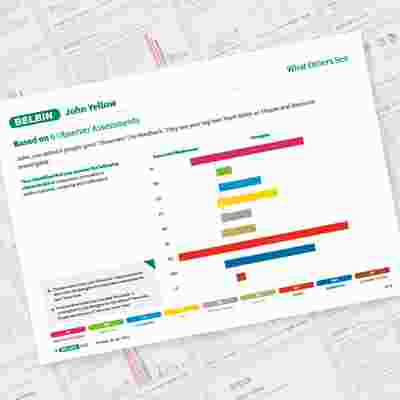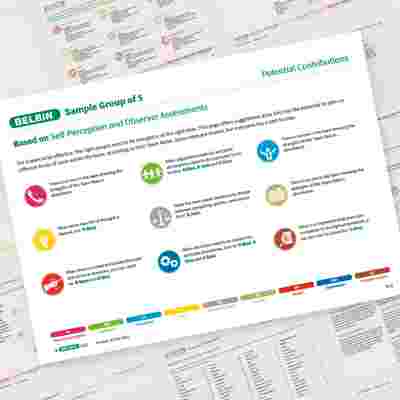It’s common knowledge that we work best when we play to our strengths – we’re more likely to be engaged, to have productive relationships with others and to take pride in our work. But there’s another statement that goes alongside that:
Individuals have strengths and weaknesses.
Study after study has highlighted the impact of weaknesses on turnover, employee engagement and retention. Gallup calls it “arguably the biggest discovery […] made on the subject of human development in the workplace”:
“Gallup has discovered that weaknesses never develop into strengths, while strengths develop infinitely. […] Organizations shouldn’t ignore weaknesses. Rather, they should minimize weaknesses and maximize strengths.”
They’ve drawn conclusions as to the importance of acknowledging and addressing the subject of ‘weakness’ in our working lives, and yet, as an industry, we fail to address the issue. We constantly refer to ‘challenges’ or ‘areas for development’ instead and continue with ‘one size fits all’ competency frameworks that fly in the face of behavioural diversity.
So, why the disconnect between theory and practice?
Perhaps we feel that talking about weaknesses isn’t as positive or encouraging as talking about strengths? Maybe we fear that labelling something a ‘weakness’ restricts opportunities for growth, learning and self-improvement? Or, do we think that talk of weaknesses alongside strengths will encourage people to cherry-pick?
The fact is, none of these ideas are born out in reality. Discussions of weaknesses are only demotivating if the focus is on trying to force the individual to improve in weak areas. And forcing efforts in this direction has a detrimental effect on our strengths, because we don’t have the time to develop and cultivate our talents. Of course, we can’t always choose which kinds of work we are given, but we can work towards an environment where an individual is playing to strengths more often than not. Having a sound understanding of our strengths and weaknesses helps us to take responsibility for both.
“Building on employees’ strengths is more effective than trying to improve their weaknesses. Weaknesses shouldn’t be ignored, but a strengths focus offers managers a better chance to develop individuals in the context of who they are, instead of attempting to change their personalities.”
– Gallup, State of the American Manager, 2013
How do we handle weaknesses for the benefit of individuals and teams?
Belbin Team Roles are clusters of behaviours, which represent different ways we might contribute and interrelate in a team. Most people have preferred roles (strengths which come naturally), manageable roles (those which can be cultivated) and least preferred roles (those which the individual finds difficult to play and are best avoided). Each Team Role is made up of a strength and an associated weakness. The associated weakness is nothing to worry about. It’s simply the flipside of the strength – it’s the trade-off for a useful behaviour. For example, a highly creative individual might be oblivious to what is going on around them when they are in the throes of a new idea. Someone who is highly organised might resist change which upsets their efficient working practices.
Uncovering strengths and weaknesses
To discover the hidden resources in your team, start with the Belbin Individual Reports. Ensure that everyone in your team obtains Observer feedback, to give a constructive, rounded picture of both strengths and weaknesses, and to ensure that the impact of individual behaviours upon the team can be understood.

Observed Team Role Strengths and Weaknesses
This page can elucidate where Team Role weaknesses might be impinging upon an individual's performance.
Where strengths outweigh the associated weaknesses (for Resource Investigator, Completer Finisher and Specialist in this example), the team still benefits from the individual playing the roles in question, and strategies can be devised to manage any difficulties caused by the associated weaknesses.
Where observed weaknesses outweigh the individual's strength in that Team Role (in this case, for the Shaper role), it isn't worth the individual attempting to play that role, and it is worth investigating why these behaviours are in evidence? Does the individual feel that the Shaper role is needed but missing in the team? Is the person in question displaying these behaviours without realising? This Report can provide an opening for discussion and further exploration, depersonalising the idea of weakness and enabling individuals to develop a strategy for managing it. If required, the List of Observer Responses Report page can provide more detail as to the precise nature of the behaviours being identified.
But it’s not only the associated weaknesses of our preferred roles that we need to handle. We also need to consider the strengths of our least preferred roles, and develop a strategy for managing work which requires those contributions. That’s where the rest of the team comes in.
Developing a strategy to mitigate weaknesses
To foster a healthy, team-focused attitude to weaknesses, individuals need to understand that they are responsible for managing their weaknesses and mitigating the effect of these upon their work. With a balanced, functional team, each individual will be playing to their strengths and working with others to ensure that everyone’s weaknesses are covered.
So, how do you manage your weaknesses effectively? It comes down to respect.
- Choose the right person.
Unless you know the Team Roles of others in your team, you may not find the right person to take on the job in question.

Belbin Team Reports collate individual Team Role data to analyse how a team might work together – who might be best suited to different types of work, and where the gaps or overlaps in the team might be.
This information can provide useful leads to team members seeking to form complementary working partnerships or establish working teams for a particular task or project.
- Show willing.
Take the task as far as you can, to the limits of your ability. This might involve cultivating manageable roles, and this offers a great learning opportunity. People who over-delegate and back off will soon earn a negative reputation, and others will be unlikely to be willing to help again in future.
- Announce why you’re handing it over.
Explain why you think the other person will do a better job. This demonstrates your understanding of, and respect for, a Team Role strength which is different to your own, and is likely to be well received. Of course, this means being honest with yourself about the reasons for delegating. If it’s just because it’s something you don’t want to do, it’s likely to cause resentment.
- Keep ownership.
You can still have responsibility for an issue or project even if you’re not the one doing all the work. Again, this demonstrates that you are capitalising on the team’s strengths, not passing the buck.
- Approach the person in the right way.
Since you’re asking for help, meet people where they are, rather than where you are. If you’re approaching a Monitor Evaluator, present things logically and dispassionately, and allow them time to think things through. If you’re delegating a task to an Implementer, define it in clear terms so that they can formulate a plan.
- Allow for a different Team Role approach.
If you ask for help, let your colleague do their thing! For example, if you’re a Resource Investigator asking a Completer Finisher to proof-read a document, don’t complain if they take a long time over it and note every last detail.
- Credit where credit’s due.
Of course, it’s only fair to acknowledge your colleagues’ help when the project succeeds.
For many, identifying and understanding weaknesses – and developing a strategy to manage them – is uplifting. It banishes feelings of inadequacy, builds relationships with colleagues and frees up precious time to work to, and develop, proven and latent strengths.
Next Steps
Looking to begin your Belbin journey? Read more about our Reports, workshops, exercises and practical session ideas or get in touch to find out how we can help.
Discover individual and team strengths using Belbin Team Role reports

Belbin Individual Reports
Before you can analyse your teams, you need to look at each individual's contribution. So, the first thing you will need to do is to generate a Belbin Individual report for each member of the team.
Find out more
Belbin Team Reports
Whether you're forming a new team, introducing new people to an existing team, or trying to resolve issues within a team, a Belbin Team report can help you to manage it.
Discover more
Why Use Belbin?
Belbin Team Roles are used to identify behavioural strengths and weaknesses in the workplace. Whether developing people, resolving conflict or fine-tuning high performance...
Read moreContact us
Please fill out the form and we'll be in touch.